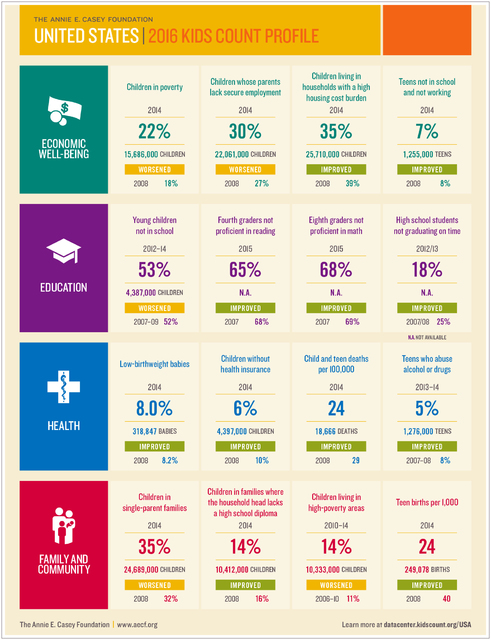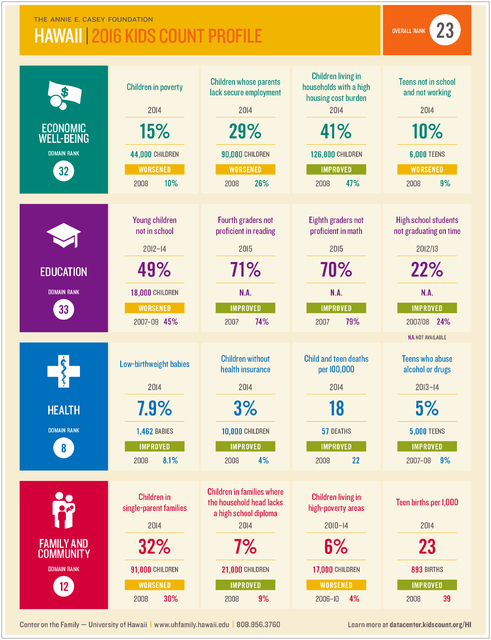A growing number of Hawaii children live in poverty, a report released Tuesday shows, though the state has made significant gains in education and health.
The 2016 Kids Count report, a yearly, state-by-state compilation by the Annie E. Casey Foundation, measures four areas to determine overall child well-being — education, health, economic well-being and family/community.
This year’s report shows 15 percent of Hawaii kids were in poverty in 2014, up from 10 percent in 2008. Nationally, that number was 22 percent.
Twenty-nine percent of Hawaii children’s parents lacked secure employment in 2014, the report shows, up from 26 percent in 2008 but slightly lower than the national 30 percent rate.
The report didn’t provide county-level information, but past Kids Count data indicate child poverty rates in Hawaii County are probably even higher. Nearly 26 percent of Big Island children lived below the federal poverty line in 2013, which was higher than every other county in the state.
“Poverty has persisted in Hawaii,” said Ivette Rodriguez Stern, Hawaii Kids Count project director at the University of Hawaii Center on the Family. “Years after the recession, we’re still seeing an increasing number of children growing up in harsh economic conditions.”
Hawaii’s lowest score in the report was in education — ranking No. 33 nationwide — though statistics show improvement. Seventy percent of the state’s eighth-graders were not proficient in math in 2015, down from 79 percent in 2007. Nationally, that number was 68 percent in 2015.
Twenty-two percent of Hawaii high school students didn’t graduate on time in the 2012-13 school year, a slight improvement from the 2007-08 rate of 24 percent. Seventy-one percent of fourth-graders were not proficient in reading in 2015, down from 74 percent in 2007 but higher than the 65 percent national rate.
Stern said the education data was an improvement, but there’s “still a lot of work to be done.”
Research shows a child’s reading proficiency at the end of the third grade is an indicator of future reading success, she said. About three-fourths of students who read poorly in the third grade remained poor readers in high school, and were more likely to drop out, one Yale University study showed.
“In those early years, you’re learning how to read, but by the time you get to the third grade, you really need to know how to read so you can learn everything else,” Stern said.
The state has taken steps to improve in recent years, including implementing a new reading curriculum called “Reading Wonders.” David Dinkel, principal of Chiefess Kapiolani Elementary School in Hilo, says the curriculum allows students to read at their own level, especially beneficial for those who struggle.
Dinkel said school leaders aim to help kids as much as possible, but poverty can “play a role in what access kids can and cannot get to.”
“Our school has high poverty,” he said. “For us, here at the school we try to make things available so kids can get exposure and experience.”
Hawaii made big strides in several health indicators, including its teen birth rate, which improved from 39 per 1,000 in 2008, to 23 per 1,000 in 2014. In Hawaii County, that number was 30.9 in 2013 — higher than every other county in the state.
The percentage of teens who abused drugs or alcohol statewide also dropped from 9 percent in 2007-08 to 5 percent in 2013-14.
Hawaii earned a No. 23 overall ranking — last year it was No. 24. Minnesota ranked No. 1 nationwide, and Mississippi came in last.
Email Kirsten Johnson at kjohnson@hawaiitribune-herald.com.






